Direct Observation of the Deformation Mechanism of Twin-Structured Ni NWs under Bending Strain
Abstract
:1. Introduction
2. Experimental Section
3. Results
3.1. TEM Characterisation of the Twin-Structured Ni NWs
3.2. In Situ TEM Observation of the Bending of Twin-Structured Ni NWs
3.3. Dislocation Governs Plasticity at the Low Strain Stage
3.4. In Situ Atomic-Scale Observation of Reversible fcc–bct Phase Transition
3.5. Direct Atomic-Scale Evidence of the Grain Boundary Formation through Lattice Bending
3.6. Effect of Strain Magnitude on the Deformation Mechanism of the Twin-Structural Ni NWs
4. Discussion
5. Conclusions
Author Contributions
Funding
Institutional Review Board Statement
Informed Consent Statement
Conflicts of Interest
References
- Zhu, Y.T.; Liao, X.Z.; Wu, X.L. Deformation twinning in nanocrystalline materials. Prog. Mater. Sci. 2012, 57, 1–62. [Google Scholar] [CrossRef]
- Zhu, T.; Li, J. Ultra-strength materials. Prog. Mater. Sci. 2010, 55, 710–757. [Google Scholar] [CrossRef]
- Li, X.Y.; Wei, Y.J.; Lu, L.; Lu, K.; Gao, H.J. Dislocation nucleation governed softening and maximum strength in nano-twinned metals. Nature 2010, 464, 877–880. [Google Scholar] [CrossRef] [PubMed]
- Lu, L.; Shen, Y.F.; Chen, X.H.; Qian, L.H.; Lu, K. Ultrahigh strength and high electrical conductivity in copper. Science 2004, 304, 422–426. [Google Scholar] [CrossRef]
- Long, J.Z.; Pan, Q.S.; Tao, N.R.; Lu, L. Residual stress induced tension-compression asymmetry of gradient nanograined copper. Mater. Res. Lett. 2018, 6, 456–461. [Google Scholar] [CrossRef]
- Pan, Q.S.; Zhou, H.F.; Lu, Q.H.; Gao, H.J.; Lu, L. History-independent cyclic response of nanotwinned metals. Nature 2017, 551, 214–217. [Google Scholar] [CrossRef]
- Cao, A.J.; Wei, Y.G.; Mao, S.X. Deformation mechanisms of face-centered-cubic metal nanowires with twin boundaries. Appl. Phys. Lett. 2007, 90, 151909. [Google Scholar] [CrossRef]
- Jang, D.C.; Li, X.Y.; Gao, H.J.; Greer, J.R. Deformation mechanisms in nanotwinned metal nanopillars. Nat. Nanotechnol. 2012, 7, 594–601. [Google Scholar] [CrossRef]
- Zhu, T.; Li, J.; Samanta, A.; Kim, H.G.; Suresh, S. Interfacial plasticity governs strain rate sensitivity and ductility in nanostructured metals. Proc. Natl. Acad. Sci. USA 2007, 104, 3031–3036. [Google Scholar] [CrossRef]
- Wang, L.H.; Liu, P.; Guan, P.F.; Yang, M.J.; Sun, J.L.; Cheng, Y.Q.; Hirata, A.; Zhang, Z.; Ma, E.; Chen, M.; et al. In situ atomic-scale observation of continuous and reversible lattice deformation beyond the elastic limit. Nat. Commun. 2013, 4, 2413. [Google Scholar] [CrossRef]
- Afanasyev, K.A.; Sansoz, F. Strengthening in gold nanopillars with nanoscale twins. Nano Lett. 2007, 7, 2056–2062. [Google Scholar] [CrossRef]
- Deng, C.; Sansoz, F. Near-ideal strength in gold nanowires achieved through microstructural design. ACS Nano 2009, 3, 3001–3008. [Google Scholar] [CrossRef] [PubMed]
- Wang, J.W.; Sansoz, F.; Huang, J.Y.; Liu, Y.; Sun, S.H.; Zhang, Z.; Mao, S.X. Near-ideal theoretical strength in gold nanowires containing angstrom scale twins. Nat. Commun. 2013, 4, 1742. [Google Scholar] [CrossRef] [PubMed]
- Guo, Y.Z.; Wang, Z.X.; Zhang, B.; Teng, J.; Zeng, W.J.; Zhao, Y.F.; Fu, L.B.; Li, D.W.; Ma, Y.; Song, W.X.; et al. Twin thickness and dislocation interactions affect the incoherent-twin boundary phase in face-centered cubic metals. Cell Rep. Phys. Sci. 2022, 3, 100736. [Google Scholar] [CrossRef]
- Deng, C.; Sansoz, F. Fundamental differences in the plasticity of periodically twinned nanowires in Au, Ag, Al, Cu, Pb and Ni. Acta Mater. 2009, 57, 6090–6101. [Google Scholar] [CrossRef]
- Zhu, Y.; Espinosa, H.D. An electromechanical material testing system for in situ electron microscopy and applications. Proc. Natl. Acad. Sci. USA 2005, 102, 14503–14508. [Google Scholar] [CrossRef]
- Wang, L.; Guan, P.; Teng, J.; Liu, P.; Han, X.D. New twinning route in face-centered cubic nanocrystalline metals. Nat. Commun. 2017, 8, 2142. [Google Scholar] [CrossRef]
- Kong, D.L.; Xin, T.J.; Sun, S.D.; Lu, Y.; Shu, X.Y.; Long, H.B.; Chen, Y.H.; Teng, J.; Zhang, Z.; Wang, L.H.; et al. Surface energy driven liquid-drop-like pseudoelastic behaviors and in situ atomistic mechanisms of small-sized face-centered cubic metals. Nano Lett. 2019, 19, 292. [Google Scholar] [CrossRef]
- Li, J.; Zhang, J.Y.; Liu, G.; Sun, J. Using the room temperature creep to strengthen nanotwinned Ni: The scaling behavior between the twin thickness and the grain size, Mater. Today Nano 2020, 11, 100086. [Google Scholar] [CrossRef]
- Sun, S.D.; Li, D.W.; Yang, C.P.; Fu, L.B.; Kong, D.L.; Lu, Y.; Guo, Y.Z.; Liu, D.M.; Guan, P.F.; Zhang, Z.; et al. Direct Atomic-Scale Observation of Ultrasmall Ag Nanowires that Exhibit fcc, bcc, and hcp Structures under Bending. Phys. Rev. Lett. 2022, 128, 015701. [Google Scholar] [CrossRef]
- Seo, J.H.; Yoo, Y.D.; Park, N.Y.; Yoon, S.W.; Lee, H.; Han, S.; Lee, S.W.; Seong, T.Y.; Lee, S.C.; Lee, K.B.; et al. Superplastic deformation of defect-free Au nanowires via coherent twin propagation. Nano Lett. 2011, 11, 3499–3502. [Google Scholar] [CrossRef] [PubMed]
- Lu, Y.; Song, J.; Huang, J.Y.; Lou, J. Fracture of sub-20nm ultrathin gold nanowires. Adv. Funct. Mater. 2011, 21, 3982–3989. [Google Scholar] [CrossRef]
- Han, X.D.; Zheng, K.; Zhang, Y.F.; Zhang, X.N.; Zhang, Z.; Wang, Z.L. Low-temperature in situ large-strain plasticity of silicon nanowires. Adv. Mater. 2007, 19, 2112–2118. [Google Scholar] [CrossRef]
- Landau, L.D.; Lifshitz, E.M. Theory of Elasticity; Pergamon Press: New York, NY, USA, 1986. [Google Scholar]
- Li, X.Y.; Dao, M.; Eberl, C.; Hodge, A.M.; Gao, H.J. Fracture, fatigue, and creep of nanotwinned metals. MRS Bull. 2016, 41, 298–304. [Google Scholar] [CrossRef]
- Li, X.Y.; Yin, S.; Oh, S.H.; Gao, H.J. Hardening and toughening mechanisms in nanotwinned ceramics. Scr. Mater. 2017, 133, 105–112. [Google Scholar] [CrossRef]
- Shin, Y.A.; Yin, S.; Li, X.; Lee, S.; Moon, S.; Jeong, J.; Kwon, M.; Yoo, S.J.; Kim, Y.M.; Zhang, T.; et al. Nanotwin-governed toughening mechanism in hierarchically structured biological materials. Nat. Commun. 2016, 7, 10772. [Google Scholar] [CrossRef] [PubMed]
- Wang, L.H.; Du, K.; Yang, C.P.; Teng, J.; Fu, L.B.; Guo, Y.Z.; Zhang, Z.; Han, X.D. In situ atomic-scale observation of grain size and twin thickness effect limit in twin-structural nanocrystalline platinum. Nat. Commun. 2020, 11, 1167. [Google Scholar] [CrossRef] [PubMed]
- Peng, C.; Ganesan, Y.; Lu, Y.; Lou, J. Size dependent mechanical properties of single crystalline nickel nanowires. J. Appl. Phys. 2012, 111, 063524. [Google Scholar] [CrossRef]
- Chen, Z.M.; Jin, Z.H.; Gao, H.J. Repulsive force between screw dislocation and coherent twin boundary in aluminum and copper. Phys. Rev. B 2007, 75, 212104. [Google Scholar] [CrossRef]
- Warner, D.H.; Curtin, W.A.; Qu, S. Rate dependence of crack-tip processes predicts twinning trends in fcc metals. Nat. Mater. 2007, 6, 876–881. [Google Scholar] [CrossRef]
- Liao, X.Z.; Zhou, F.; Lavernia, E.J.; He, D.W.; Zhu, Y.T. Deformation twins in nanocrystalline Al. Appl. Phy. Lett. 2003, 83, 5062–5064. [Google Scholar] [CrossRef]
- Chen, M.W.; Ma, E.; Hemker, K.J.; Sheng, H.W.; Wang, Y.M.; Cheng, X.M. Deformation twinning in nanocrystalline aluminum. Science 2003, 300, 1275–1277. [Google Scholar] [CrossRef] [PubMed]
- Yue, Y.H.; Liu, P.; Zhang, Z.; Han, X.D.; Ma, E. Approaching the theoretical elasticstrainlimit in copper nanowires. Nano Lett. 2011, 11, 3151–3155. [Google Scholar] [CrossRef] [PubMed]
- Yue, Y.H.; Liu, P.; Deng, Q.S.; Ma, E.; Zhang, Z.; Han, X.D. Quantitative evidence of crossover toward partial dislocation mediated plasticity in copper single crystalline nanowires. Nano Lett. 2012, 12, 4045–4049. [Google Scholar] [CrossRef] [PubMed]
- Bain, E.C.; Dunkirk, N.Y. The nature of martensite. Trans. Am. Inst. Min. Metall. Eng. 1924, 70, 25. [Google Scholar]
- Bowles, J.S.; Wayman, C.M. The Bain strain, lattice correspondences, and deformations related to martensitic transformations. Metall. Mater. Trans. B 1972, 3, 1113–1121. [Google Scholar] [CrossRef]
- Olson, G.B.; Cohen, M. Interphase-boundary dislocations and the concept of coherency. Acta Metall. 1979, 27, 1907–1918. [Google Scholar] [CrossRef]
- Kajiwara, S.; Ogawa, K.; Kikuchi, T. High-resolution electron microscopy observations of transient lattices from fcc to bcc at the austenite martensite interface. Phil. Mag. Lett. 1996, 74, 405–414. [Google Scholar] [CrossRef]
- Zhang, X.Y.; Wu, X.L.; Liu, Q.; Zuo, R.L.; Zhu, A.W.; Jiang, P.; Wei, Q.M. Phase transformation accommodated plasticity in nanocrystalline nickel. Appl. Phys. Lett. 2008, 93, 031901. [Google Scholar] [CrossRef]
- Murayama, M.; Howe, J.M.; Hidaka, H.; Takaki, S. Atomic-level observation of disclination dipoles in mechanically milled, nanocrystalline Fe. Science 2002, 295, 2433–2435. [Google Scholar] [CrossRef]
- Ovid’ko, I.A. Deformation of nanostructures. Science 2002, 295, 2386. [Google Scholar] [CrossRef] [PubMed]
- Komanduri, R.; Chandrasekaran, N.; Raff, L.M. Molecular dynamics (MD) simulation of uniaxial tension of some single-crystal cubic metals at nanolevel. Int. J. Mech. Sci. 2001, 43, 2237–2260. [Google Scholar] [CrossRef]
- Fu, L.B.; Yang, C.P.; Wei, R.J.; Pei, X.F.; Teng, J.; Kong, D.L.; Lu, Y.; Guo, Y.Z.; Liu, T.F.; Hu, Y.L.; et al. In situ atomic-scale observation of AuCu alloy nanowire with superplasticity and high strength at room temperature. Mater. Today Nano 2021, 15, 100123. [Google Scholar] [CrossRef]
- Fu, L.B.; Kong, D.L.; Yang, C.P.; Teng, J.; Lu, Y.; Guo, Y.Z.; Yang, G.; Yan, X.; Liu, P.; Chen, M.W.; et al. Ultra-high strength yet superplasticity in a hetero-grain-sized nanocrystalline Au nanowire. J. Mater. Sci. Technol. 2022, 101, 95–106. [Google Scholar] [CrossRef]
- Greer, J.R.; Nix, W.D. Nanoscale gold pillars strengthened through dislocation starvation. Phys. Rev. B 2006, 73, 245410. [Google Scholar] [CrossRef]
- Fu, L.B.; Yang, C.P.; Lu, Y.; Teng, J.; Kong, D.L.; Guo, Y.Z.; Zhang, Z.; Wang, L.H.; Han, X.D. In situ atomistic mechanisms of detwinning in nanocrystalline AuAg alloy. Sci. China Mater. 2022, 65, 820–826. [Google Scholar] [CrossRef]
- Seo, J.H.; Park, H.S.; Yoo, Y.; Seong, T.Y.; Li, J.; Ahn, J.P.; Kim, B.; Choi, I.S. Origin of Size Dependency in Coherent-Twin-Propagation-Mediated Tensile Deformation of Noble Metal Nanowires. Nano Lett. 2013, 13, 5112–5116. [Google Scholar] [CrossRef]
- Wang, Q.N.; Wang, J.W.; Li, J.X.; Zhang, Z.; Mao, S.X. Consecutive crystallographic reorientations and superplasticity in body-centered cubic niobium nanowires. Sci. Adv. 2018, 4, eaas8850. [Google Scholar] [CrossRef]
- Sun, S.D.; Kong, D.L.; Li, D.H.; Liao, X.Z.; Liu, D.M.; Mao, S.C.; Zhang, Z.; Wang, L.H.; Han, X.D. Atomistic mechanism of stress-induced combined slip and diffusion in sub-5 nanometer-sized Ag nanowires. ACS Nano 2019, 13, 8708–8716. [Google Scholar] [CrossRef]
- Lu, Q.H.; You, Z.S.; Huang, X.X.; Hansen, N.; Lu, L. Dependence of dislocation structure on orientation and slip systems in highly oriented nanotwinned Cu. Acta Mater. 2017, 127, 85–97. [Google Scholar] [CrossRef]
- Wang, L.H.; Zhang, Y.; Zeng, Z.; Zhou, H.; He, J.; Liu, P.; Chen, M.W.; Han, J.; Srolovitz, D.J.; Teng, J.; et al. Tracking the sliding of grain boundaries at the atomic scale. Science 2022, 375, 1261–1265. [Google Scholar] [CrossRef] [PubMed]
- Evans, A.G.; Hutchinson, J.W. A critical assessment of theories of strain gradient plasticity. Acta Mater. 2009, 57, 1675–1688. [Google Scholar] [CrossRef]
- Wang, L.H.; Teng, J.; Sha, X.C.; Zou, J.; Zhang, Z.; Han, X.D. Plastic deformation through dislocation saturation in ultrasmall Pt nanocrystals and Its in situ atomistic mechanisms. Nano Lett. 2017, 17, 4733–4739. [Google Scholar] [CrossRef] [PubMed]
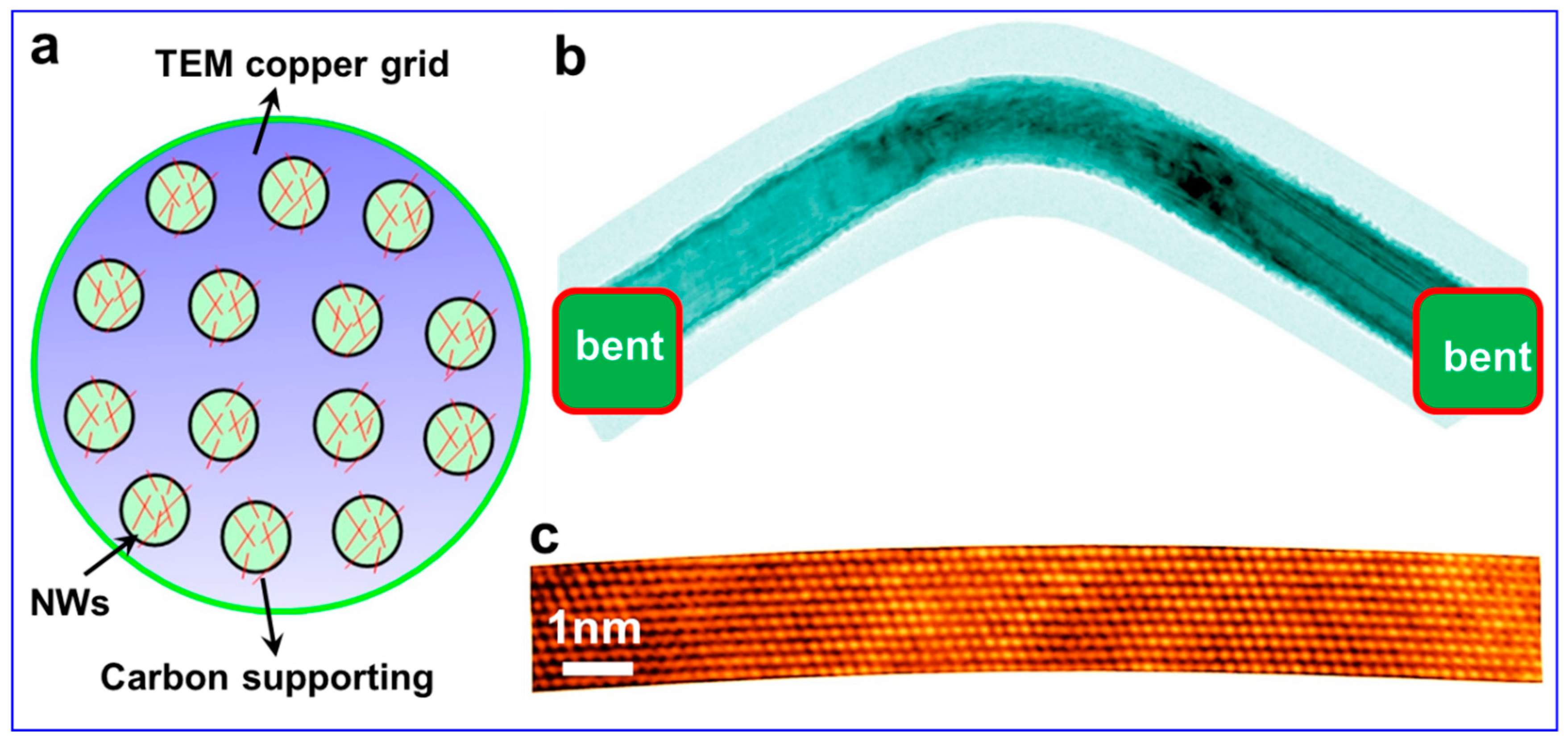
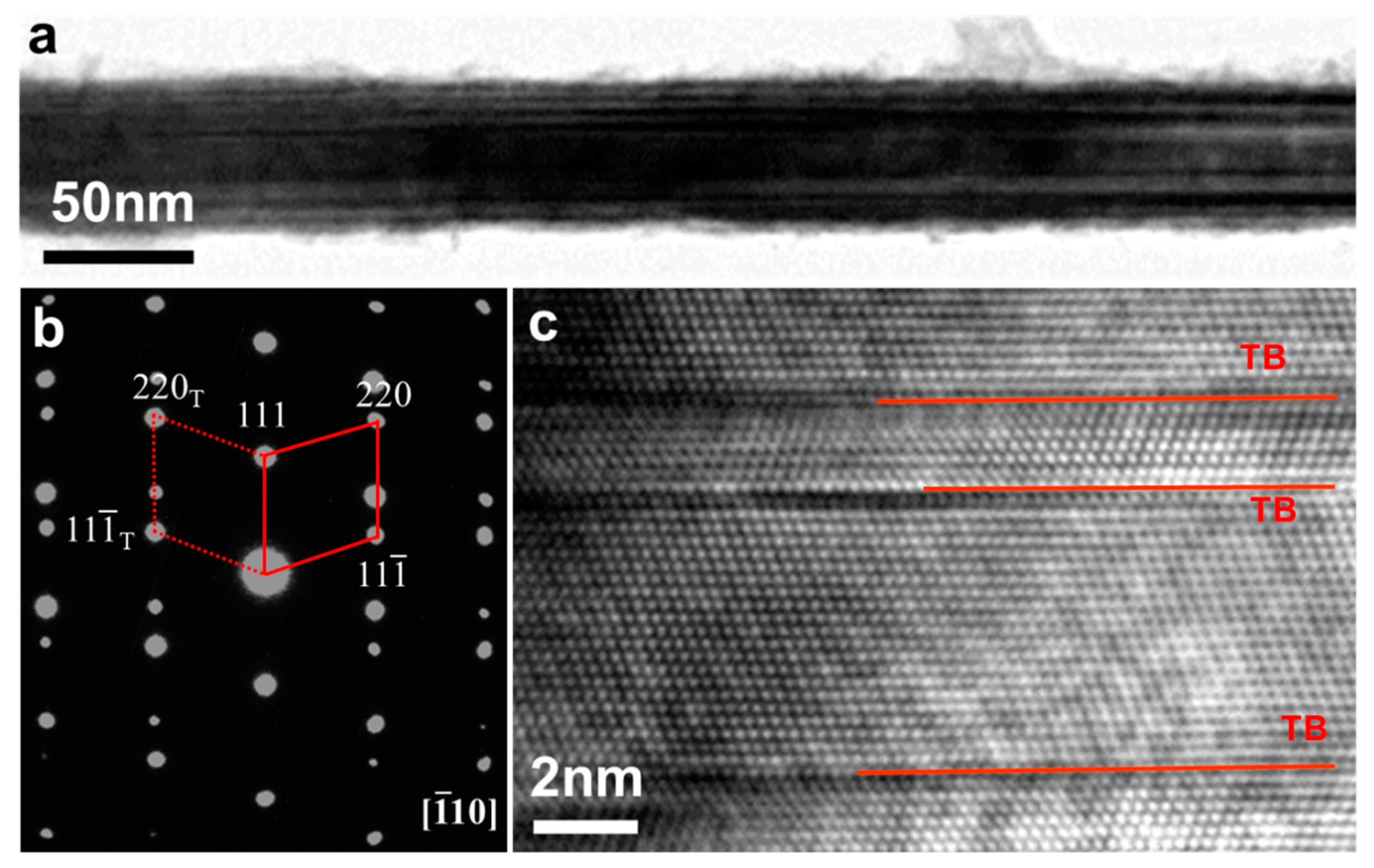
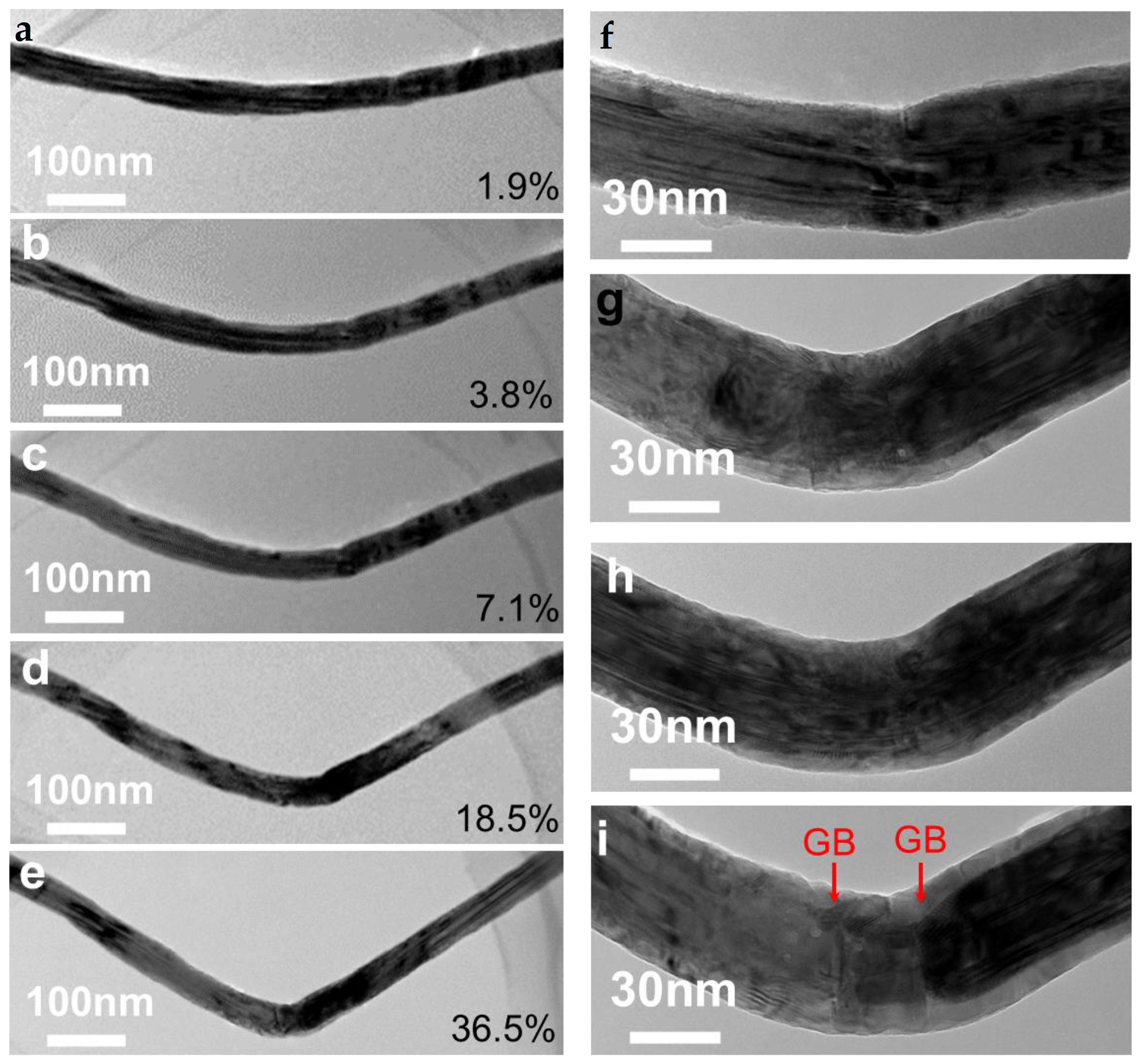
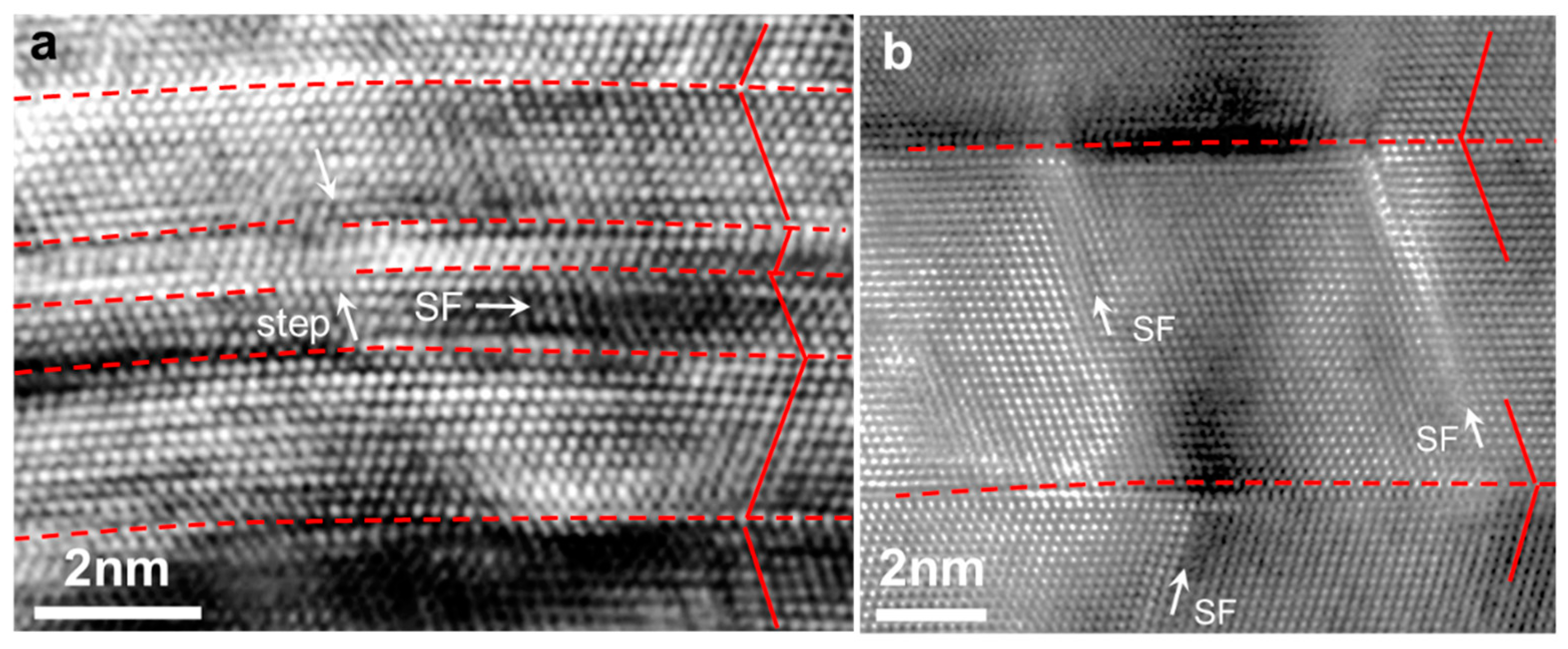
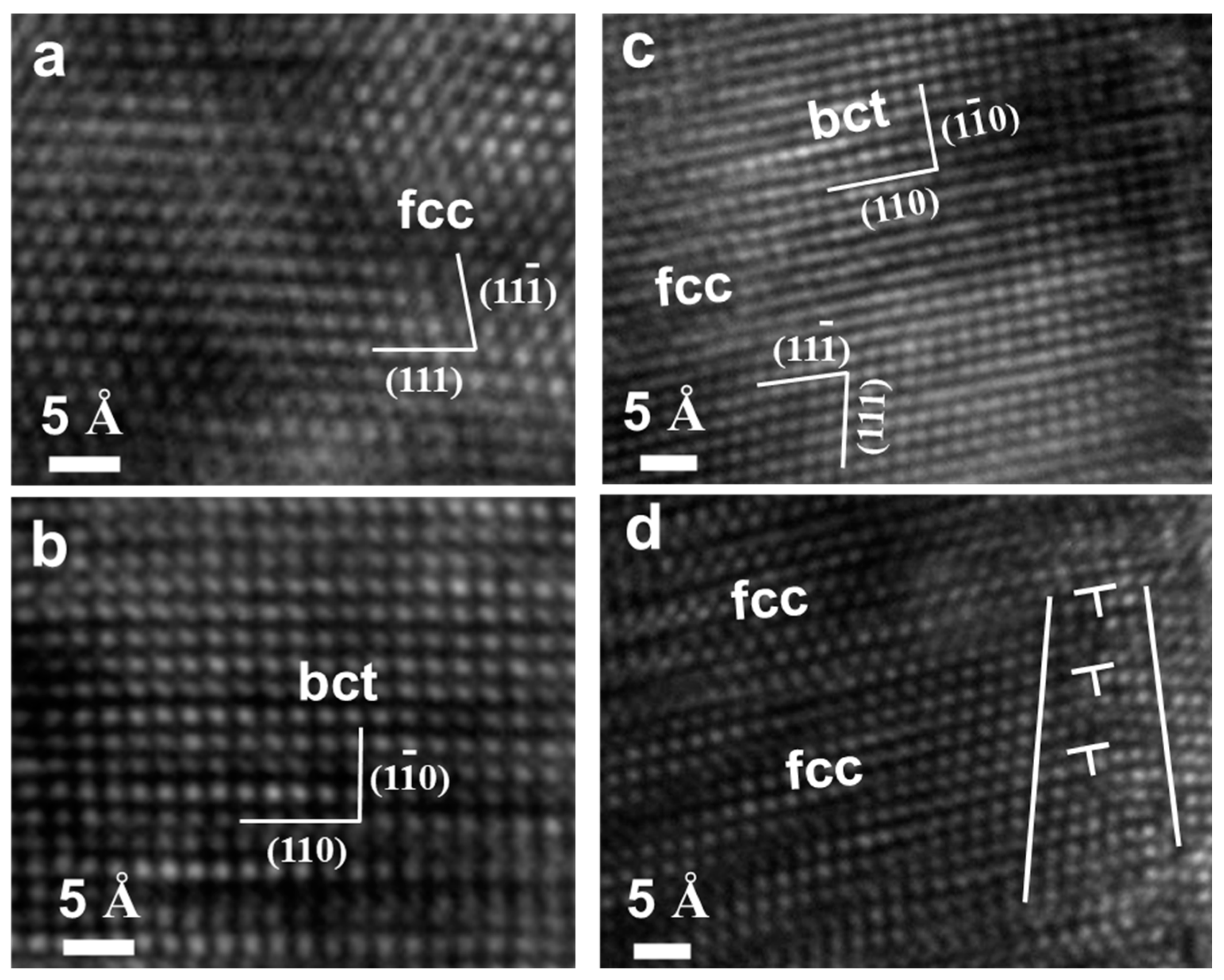
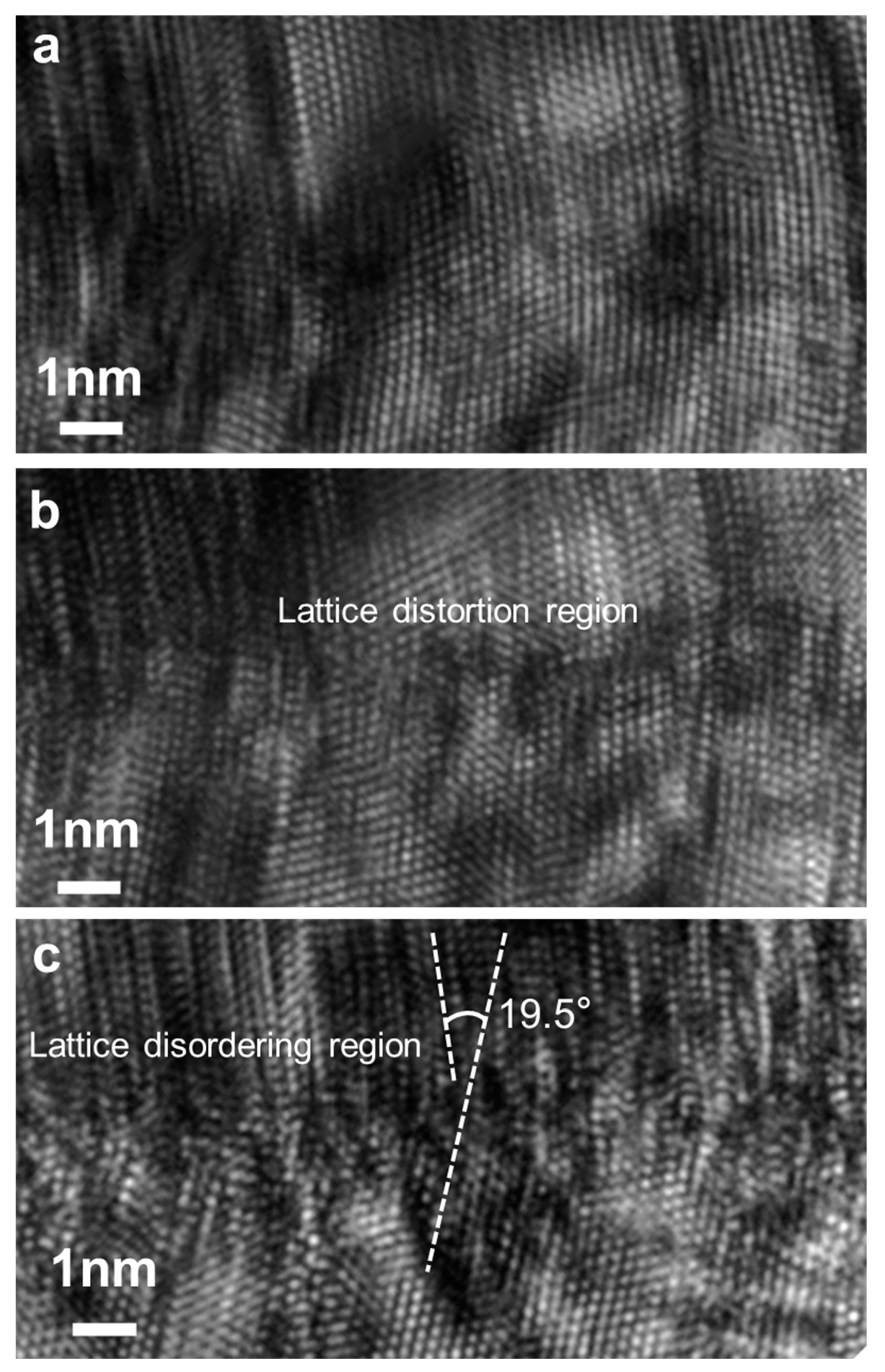
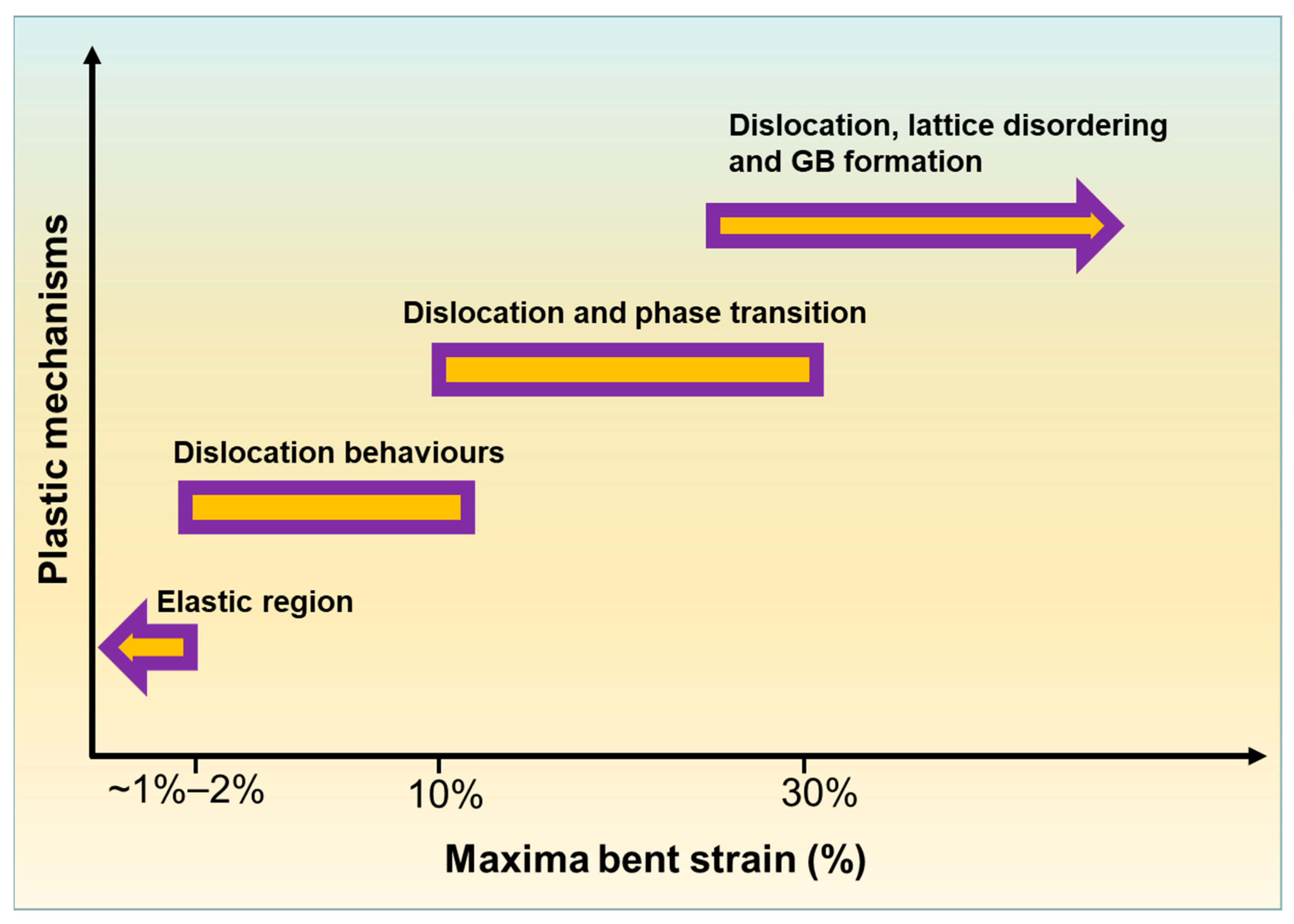
Publisher’s Note: MDPI stays neutral with regard to jurisdictional claims in published maps and institutional affiliations. |
© 2022 by the authors. Licensee MDPI, Basel, Switzerland. This article is an open access article distributed under the terms and conditions of the Creative Commons Attribution (CC BY) license (https://creativecommons.org/licenses/by/4.0/).
Share and Cite
Zhang, Z.; Yang, C.; Guo, Y.; Li, X.; Kong, D.; Lu, Y.; Nie, C.; Wang, L. Direct Observation of the Deformation Mechanism of Twin-Structured Ni NWs under Bending Strain. Metals 2022, 12, 1623. https://doi.org/10.3390/met12101623
Zhang Z, Yang C, Guo Y, Li X, Kong D, Lu Y, Nie C, Wang L. Direct Observation of the Deformation Mechanism of Twin-Structured Ni NWs under Bending Strain. Metals. 2022; 12(10):1623. https://doi.org/10.3390/met12101623
Chicago/Turabian StyleZhang, Zihao, Chengpeng Yang, Yizhong Guo, Xueqiao Li, Deli Kong, Yan Lu, Changjiang Nie, and Lihua Wang. 2022. "Direct Observation of the Deformation Mechanism of Twin-Structured Ni NWs under Bending Strain" Metals 12, no. 10: 1623. https://doi.org/10.3390/met12101623
APA StyleZhang, Z., Yang, C., Guo, Y., Li, X., Kong, D., Lu, Y., Nie, C., & Wang, L. (2022). Direct Observation of the Deformation Mechanism of Twin-Structured Ni NWs under Bending Strain. Metals, 12(10), 1623. https://doi.org/10.3390/met12101623






